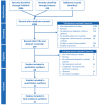How 'idiopathic' is adolescent idiopathic scoliosis? A systematic review on associated abnormalities
- PMID: 24820478
- PMCID: PMC4018432
- DOI: 10.1371/journal.pone.0097461
How 'idiopathic' is adolescent idiopathic scoliosis? A systematic review on associated abnormalities
Abstract
Background: Despite more than a century of dedicated research, the etiology and pathogenesis of adolescent idiopathic scoliosis (AIS) remain unclear. By definition, 'idiopathic' implies an unknown cause. Nevertheless, many abnormalities concomitant to AIS have been described, often with the suggestion that these abnormalities are related to etio-pathogenesis. Insight in the concomitant abnormalities may assist in improving the understanding of the etiological pathways of AIS. We aimed to systematically review and synthesize available studies on abnormalities concomitant to AIS.
Methods: Original studies comparing untreated AIS patients with healthy adolescents on abnormalities other than the deformity of the spine were retrieved from PubMed and Embase. We followed PRISMA guidelines and to quantify the relationship between each abnormality and AIS we used a best-evidence-syntheses for relating risk-of-bias to consistency of effect sizes.
Results: We identified 88 relevant citations, forty-seven carried high risk-of-bias and twenty studies did not report quantitative data in a sufficient manner. The remaining twenty-one publications failed to report data from before initiation of the deformity and blind assessments. These cross-sectional studies provided data on fourteen abnormalities concomitant to AIS. With our best-evidence-syntheses we were unable to find both strong evidence and a consistent pattern of occurrence for AIS and any of these abnormalities. From moderate risk-of-bias studies a relatively consistent pattern of occurrence for AIS and impaired gait control (4 studies; 155 subjects; Cohen's d = 1.00) and decreased bone mineral density (2 studies; 954 subjects; Cohen's d = -0.83) was found. For nine abnormalities a consistent pattern of occurrence with AIS was found, but the evidence for these was weak.
Conclusions: Based on the available literature, strong evidence is lacking for a consistent pattern of occurrence of AIS and any abnormality. The relevance for understanding the multifactorial etiology of AIS is very limited.
Conflict of interest statement
Figures



References
-
- Nicoladoni C (1904) Anatomie und mechanismus der skoliose. Stuttgart: Verlag von Erwin Nagele.
-
- Lonstein JE (1994) Adolescent idiopathic scoliosis. Lancet 344: 1407–1412. - PubMed
-
- Altaf F, Gibson A, Dannawi Z, Noordeen H (2013) Adolescent idiopathic scoliosis. BMJ 346: f2508 10.1136/bmj.f2508. - PubMed
-
- Parent S, Newton PO, Wenger DR (2005) Adolescent idiopathic scoliosis: Etiology, anatomy, natural history, and bracing. Instr Course Lect 54: 529–536. - PubMed
Publication types
MeSH terms
LinkOut - more resources
Full Text Sources
Other Literature Sources
Medical

